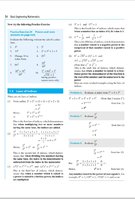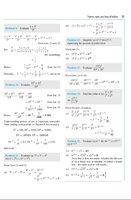You are using an out of date browser. It may not display this or other websites correctly.
You should upgrade or use an alternative browser.
You should upgrade or use an alternative browser.
Weird power
- Thread starter Yuseph
- Start date
Dr.Peterson
Elite Member
- Joined
- Nov 12, 2017
- Messages
- 16,617
Yes, this is very ordinary stuff:Yo guys,
Dont tell me you guys see this horror very often.
Fractional Exponents
The exponent of a number says how many times to use the number in a multiplication. So what does a fractional exponent mean?
www.mathsisfun.com

What do rational (fractional) exponents mean?
Rational (or fractional) exponents indicate radicals (or roots). For instance, 9^(½) means √(9), or "the square root of 9", which is 3.
Dr.Peterson
Elite Member
- Joined
- Nov 12, 2017
- Messages
- 16,617
I should add that your image doesn't accurately express what they are doing.
You can write [MATH]8^{\frac{2}{3}}[/MATH] either as [MATH]\sqrt[3]{8^2}[/MATH] as they did, or as [MATH]\sqrt[3]{8}^2[/MATH]; it is the latter, not the former, that naturally leads to [MATH]2^2 = 4[/MATH]. What they wrote is really [MATH]\sqrt[3]{64} = 4[/MATH].
Generally, if the base is a perfect power, you should put the exponent on the outside to keep numbers small, while if all you can do is to simplify, the other way may work better.
You can write [MATH]8^{\frac{2}{3}}[/MATH] either as [MATH]\sqrt[3]{8^2}[/MATH] as they did, or as [MATH]\sqrt[3]{8}^2[/MATH]; it is the latter, not the former, that naturally leads to [MATH]2^2 = 4[/MATH]. What they wrote is really [MATH]\sqrt[3]{64} = 4[/MATH].
Generally, if the base is a perfect power, you should put the exponent on the outside to keep numbers small, while if all you can do is to simplify, the other way may work better.
pka
Elite Member
- Joined
- Jan 29, 2005
- Messages
- 11,976
I see a bad mistake in the above \(\large\color{red}\sqrt{25}\ne\pm 5\): c it should be \(\large\color{blue}\sqrt{25}= 5\).
There are two square roots of \(25\) and they are \(\pm 5=\pm\sqrt{25}\)
Yuseph
Junior Member
- Joined
- Aug 5, 2020
- Messages
- 68
Right. So you're telling me i should totally erase from my memory whats on the picture.I see a bad mistake in the above \(\large\color{red}\sqrt{25}\ne\pm 5\): c it should be \(\large\color{blue}\sqrt{25}= 5\).
There are two square roots of \(25\) and they are \(\pm 5=\pm\sqrt{25}\)
Attachments
Dr.Peterson
Elite Member
- Joined
- Nov 12, 2017
- Messages
- 16,617
Maybe not erase it all, but put an asterisk on it. There are times when one might choose to treat the square root as double-valued, and many cases where you have to keep in mind that there are two roots. For example, in solving an equation, if you raise both sides to the 3/4 power, you need to realize that that is an even root, so you will need to include [MATH]\pm[/MATH] before the radical in your result. So, don't entirely forget that, but don't write what they wrote unless it has been explicitly stated for some reason that you can. (And I can't think of a specific instance where you would!)Right. So you're telling me i should totally erase from my memory whats on the picture.
The big question now it, what is your source? I'd like to see whether their context justifies what they are saying in some way, or whether they are just wrong.
Yuseph
Junior Member
- Joined
- Aug 5, 2020
- Messages
- 68
Basic engineering mathematics by john bird. Chapter 7.Maybe not erase it all, but put an asterisk on it. There are times when one might choose to treat the square root as double-valued, and many cases where you have to keep in mind that there are two roots. For example, in solving an equation, if you raise both sides to the 3/4 power, you need to realize that that is an even root, so you will need to include [MATH]\pm[/MATH] before the radical in your result. So, don't entirely forget that, but don't write what they wrote unless it has been explicitly stated for some reason that you can. (And I can't think of a specific instance where you would!)
The big question now it, what is your source? I'd like to see whether their context justifies what they are saying in some way, or whether they are just wrong.
Theres no context he's saying its that way and it must be applied that way.
And since Ive seen the 3rd volume of his trilogy laplace transforms and stuff, i dont wanna contradict the guy.
Cubist
Senior Member
- Joined
- Oct 29, 2019
- Messages
- 1,686
I think there's a difference between the words "square root(s) of x" and the mathematical function sqrt(x).
Dr. Peterson is correct that you might want to "put an asterisk" on it! When you study complex numbers then things should become more clear to you. It might surprise you that there are 3 cube roots of any number, and there are 4 possible fourth roots of a number, etc within the realm of complex numbers.
My background is in computer programming, and I know that the sqrt() function will always return one result, just the +ve root. It does not return two values. I think this is the same for the mathematical version of sqrt() too. However I'm aware that the words "square root", as opposed to the function sqrt(), does imply two solutions, both the +ve and the -ve. But the symbol √, and its function sqrt(), will always return just the +ve value because it does not need to be ambiguous.
There is an analogy here about sin and arcsin. The arcsin function returns a SINGLE value assuming a particular domain of the original "sin" function. But there are actually many values of x where sin(x)=y beyond the value x=arcsin(y)
Dr. Peterson is correct that you might want to "put an asterisk" on it! When you study complex numbers then things should become more clear to you. It might surprise you that there are 3 cube roots of any number, and there are 4 possible fourth roots of a number, etc within the realm of complex numbers.
My background is in computer programming, and I know that the sqrt() function will always return one result, just the +ve root. It does not return two values. I think this is the same for the mathematical version of sqrt() too. However I'm aware that the words "square root", as opposed to the function sqrt(), does imply two solutions, both the +ve and the -ve. But the symbol √, and its function sqrt(), will always return just the +ve value because it does not need to be ambiguous.
There is an analogy here about sin and arcsin. The arcsin function returns a SINGLE value assuming a particular domain of the original "sin" function. But there are actually many values of x where sin(x)=y beyond the value x=arcsin(y)
Dr.Peterson
Elite Member
- Joined
- Nov 12, 2017
- Messages
- 16,617
I found an older edition of the book online (probably illegally); there, the bit you quoted is in section 3.1, soon after introducing the square root this way:Basic engineering mathematics by john bird. Chapter 7.
Theres no context he's saying its that way and it must be applied that way.
And since Ive seen the 3rd volume of his trilogy laplace transforms and stuff, i dont wanna contradict the guy.

It's clear he's coming at this as an engineer, not a mathematician, and therefore isn't terribly careful about details. It's somewhat forgivable (yes, I'm far too lenient) in this context, but if he ever goes on to do any serious work with functions, something will go wrong. When we write a particular symbol, it has to have only one meaning, or we will get ourselves into trouble.
The right way to say it is that when you take a square root in the course of solving an equation, you have to write it like this: The square roots of 4 are [MATH]\pm\sqrt{4} = \pm 2[/MATH].
Cubist
Senior Member
- Joined
- Oct 29, 2019
- Messages
- 1,686
I think it is fair to say that John Bird is probably more clever and successful than me, but in this particular context he's wrong. I personally met an engineer at Imperial College who thought that Pi was exactly 22/7. This mistake didn't mean that he was stupid, in fact he was extremely clever, but he had just forgotten (or had never been shown) some of the basic principles of mathematics.
Yuseph
Junior Member
- Joined
- Aug 5, 2020
- Messages
- 68
You re definitely a purist. But yea that makes sense. The guy didnt consider that small detail at all.I should add that your image doesn't accurately express what they are doing.
You can write [MATH]8^{\frac{2}{3}}[/MATH] either as [MATH]\sqrt[3]{8^2}[/MATH] as they did, or as [MATH]\sqrt[3]{8}^2[/MATH]; it is the latter, not the former, that naturally leads to [MATH]2^2 = 4[/MATH]. What they wrote is really [MATH]\sqrt[3]{64} = 4[/MATH].
Generally, if the base is a perfect power, you should put the exponent on the outside to keep numbers small, while if all you can do is to simplify, the other way may work better.
Yuseph
Junior Member
- Joined
- Aug 5, 2020
- Messages
- 68
Ok ill be careful about that minus plus thing. Thanks for taking the time to look into the book. Im doing one chapter per day dyou think once im done with it ill be ready for linear algebra and the maths needed for machine learning or will i have to dig deaper into the 2nd volume ?I found an older edition of the book online (probably illegally); there, the bit you quoted is in section 3.1, soon after introducing the square root this way:
View attachment 21047
It's clear he's coming at this as an engineer, not a mathematician, and therefore isn't terribly careful about details. It's somewhat forgivable (yes, I'm far too lenient) in this context, but if he ever goes on to do any serious work with functions, something will go wrong. When we write a particular symbol, it has to have only one meaning, or we will get ourselves into trouble.
The right way to say it is that when you take a square root in the course of solving an equation, you have to write it like this: The square roots of 4 are [MATH]\pm\sqrt{4} = \pm 2[/MATH].




